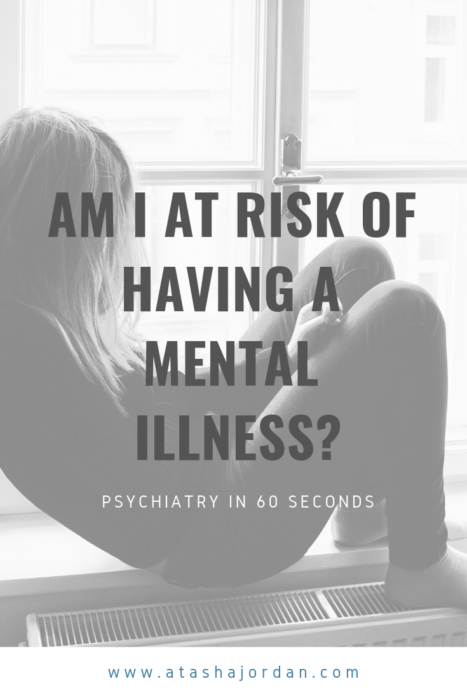Mental illness is on the rise in the US, and this might leave you wondering whether or not you are at risk of having a mental illness at some point in your life. The short answer is yes, but there are some avoidable mental illness risk factors.
Check out the video below for a quick 60-second explanation of different mental illness risk factors and steps you can take to minimize your chances of developing a psychiatric illness.
Want to know more? Keep reading below for more details!
MENTAL ILLNESS RISK FACTORS
GENETICS
Some psychiatric disorders, such as bipolar disorder and schizophrenia, have strong genetic links. In other words, for some mental illnesses, your risk of having the illness is increased because of the genes that you were born with. However, having a family member with a mental illness does not mean that you will definitely have the condition as well. You should, nonetheless, be aware of the signs and symptoms associated with the genetically-linked disorder, so that you can seek help as early as possible if needed.
DRUGS AND ALCOHOL
Drugs and alcohol are a double whammy as far as mental illness risk factors are concerned. First, drug use disorder (i.e. addiction) has a genetic component. Due to your genetic makeup, you might be at a higher risk of becoming dependent on drugs and alcohol. If you know that you have a family history of drug or alcohol addiction, it may be important for you to discuss abstinence with your medical provider.
Another way that drugs and alcohol impact your mental health risk factors relates to their link with the onset of conditions such as depression and psychosis. PCP and LSD are examples of drugs that can cause psychosis. Though drug-induced psychosis is often reversible once the drugs have left your system, there are some cases where drugs can unmask underlying psychiatric illness such as bipolar disorder or schizophrenia. Similarly, alcohol misuse can unmask or trigger depression in persons who are genetically predisposed.
ENVIRONMENTAL FACTORS
Emotional or physical traumas in addition to other life stressors are mental illness risk factors for conditions such as generalized anxiety disorder (GAD) or post-traumatic stress disorder (PTSD).
PREVALENCE AND INCIDENCE OF MENTAL ILLNESS IN THE US
Disease prevalence relates to how many people in a population have a given illness. Incidence measures how many people are newly diagnosed with a disease in a given time frame. Knowing the incidence of disease helps you to get a very rough sense of how likely you are to get a disease, whereas prevalence tells you how common the disease it overall. As we uncover the true prevalence of psychiatric illnesses, this has helped to reduce the stigma related with mental health issues because people realize that they are not alone.
I’ve included the figure below to further highlight the idea that mental illness, on the whole, is by no means uncommon, but the prevalence of specific mental illnesses is often low. The chart shows the percent breakdown of mental illness for adults in the US.

Almost 1 in 5 American adults has a mental illness
PROTECTIVE FACTORS AGAINST MENTAL ILLNESS
HAVE A STRONG SUPPORT SYSTEM
The people in your circle can build you up or tear you down. When things are tough, do you have people who you can depend on to lend a listening ear? Do your friends encourage destructive habits or do they help nudge you toward the help that you need? Finding a strong support system is key for anyone trying to navigate the challenges that life presents
AVOID DRUGS AND ALCOHOL
As I mentioned above, drugs and alcohol can lead to mental illness. So if you’re worried that you are at risk of having a mental illness, drug and alcohol abstinence can serve as a key protective factor.
UNDERSTAND HOW YOUR THOUGHTS, EMOTIONS, AND BEHAVIORS INTERPLAY
My blog series on the Cognitive Behavior Therapy Triangle is one of my favorite blog creations to date. I routinely go back to these posts for my own wellness! In the Cognitive Behavioral Therapy Triangle blog series, I explain the relationship between thoughts, emotions, and behaviors. As you work to understand the connections between these factors, you can help to minimize your chances of experiencing depression or anxiety.
****************************
I hope this post helps you to have a better understanding of your mental health risk factors. The post is not intended to provide medical advice. As always, if you have concerns about your mental health, please seek help from your healthcare provider!
Peace and blessings,
Atasha Jordan, MD (to be)






